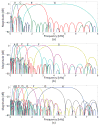A Fully-Implantable Cochlear Implant SoC with Piezoelectric Middle-Ear Sensor and Arbitrary Waveform Neural Stimulation
- PMID: 26251552
- PMCID: PMC4523309
- DOI: 10.1109/JSSC.2014.2355822
A Fully-Implantable Cochlear Implant SoC with Piezoelectric Middle-Ear Sensor and Arbitrary Waveform Neural Stimulation
Abstract
A system-on-chip for an invisible, fully-implantable cochlear implant is presented. Implantable acoustic sensing is achieved by interfacing the SoC to a piezoelectric sensor that detects the sound-induced motion of the middle ear. Measurements from human cadaveric ears demonstrate that the sensor can detect sounds between 40 and 90 dB SPL over the speech bandwidth. A highly-reconfigurable digital sound processor enables system power scalability by reconfiguring the number of channels, and provides programmable features to enable a patient-specific fit. A mixed-signal arbitrary waveform neural stimulator enables energy-optimal stimulation pulses to be delivered to the auditory nerve. The energy-optimal waveform is validated with in-vivo measurements from four human subjects which show a 15% to 35% energy saving over the conventional rectangular waveform. Prototyped in a 0.18 μm high-voltage CMOS technology, the SoC in 8-channel mode consumes 572 μW of power including stimulation. The SoC integrates implantable acoustic sensing, sound processing, and neural stimulation on one chip to minimize the implant size, and proof-of-concept is demonstrated with measurements from a human cadaver ear.
Keywords: Arbitrary waveform; SoC; cochlear implant; energy-efficient; hearing loss; implantable; low-voltage; microphone; middle ear; piezoelectric; reconfigurable; stimulation; ultra-low-power.
Figures


















References
-
- Young DJ, Zurcher MA, Semaan M, Megerian CA, Ko WH. MEMS capacitive accelerometer-based middle ear microphone. IEEE Trans Biomed Eng. 2012 Dec;59(12):3283–3292. - PubMed
-
- Germanovix W, Toumazou C. Design of a micropower current-mode log-domain analog cochlear implant. IEEE Trans Circuits Syst II. 2000 Oct;47(10):1023–1046.
-
- Sarpeshkar R, Baker MW, Salthouse CD, Sit JJ, Turicchia L, Zhak SM. An analog bionic ear processor with zero-crossing detection. IEEE Int. Solid-State Circuits Conf. Dig. Tech. Papers; San Francisco, CA. Feb. 2005; pp. 78–79.
-
- Whiten DM. PhD dissertation. Massachusetts Institute of Technology; Cambridge, MA: Feb, 2007. Electro-anatomical models of the cochlear implant.
Grants and funding
LinkOut - more resources
Full Text Sources
Other Literature Sources
Miscellaneous
